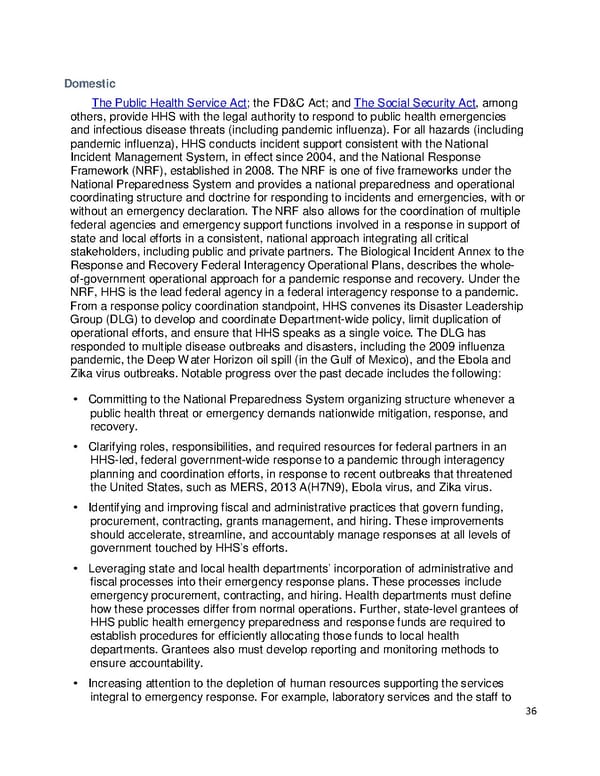Domestic The Public Health Service Act; the FD&C Act; and The Social Security Act, among others, provide HHS with the legal authority to respond to public health emergencies and infectious disease threats (including pandemic influenza). For all hazards (including pandemic influenza), HHS conducts incident support consistent with the National Incident Management System, in effect since 2004, and the National Response Framework (NRF), established in 2008. The NRF is one of five frameworks under the National Preparedness System and provides a national preparedness and operational coordinating structure and doctrine for responding to incidents and emergencies, with or allows for the coordination of multiple without an emergency declaration. The NRF also federal agencies and emergency support functions involved in a response in support of state and local efforts in a consistent, national approach integrating all critical stakeholders, including public and private partners. The Biological Incident Annex to the Response and Recovery Federal Interagency Operational Plans, describes the whole- of-government operational approach for a pandemic response and recovery. Under the NRF, HHS is the lead federal agency in a federal interagency response to a pandemic. From a response policy coordination standpoint, HHS convenes its Disaster Leadership artment-wide poli Group (DLG) to develop and coordinate Dep cy, limit duplication of operational efforts, and ensure that HHS speaks as a single voice. The DLG has responded to multiple disease outbreaks and disasters, including the 2009 influenza pandemic, the Deep Water Horizon oil spill (in the Gulf of Mexico), and the Ebola and Zika virus outbreaks. Notable progress over the past decade includes the following: • Committing to the National Preparedness System organizing structure whenever a public health threat or emergency demands nationwide mitigation, response, and recovery. • Clarifying roles, responsibilities, and required resources for federal partners in an HHS-led, federal government-wide response to a pandemic through interagency planning and coordination efforts, in response to recent outbreaks that threatened the United States, such as MERS, 2013 A(H7N9), Ebola virus, and Zika virus. • Identifying and improving fiscal and administrative practices that govern funding, procurement, contracting, grants management, and hiring. These improvements should accelerate, streamline, and accountably manage responses at all levels of government touched by HHS’s efforts. • Leveraging state and local health departments’ incorporation of administrative and fiscal processes into their emergency response plans. These processes include emergency procurement, contracting, and hiring. Health departments must define how these processes differ from normal operations. Further, state-level grantees of HHS public health emergency preparedness and response funds are required to establish procedures for efficiently allocating those funds to local health departments. Grantees also must develop reporting and monitoring methods to ensure accountability. • Increasing attention to the depletion of human resources supporting the services integral to emergency response. For example, laboratory services and the staff to 36
 Pandemic Influenza Plan Page 35 Page 37
Pandemic Influenza Plan Page 35 Page 37